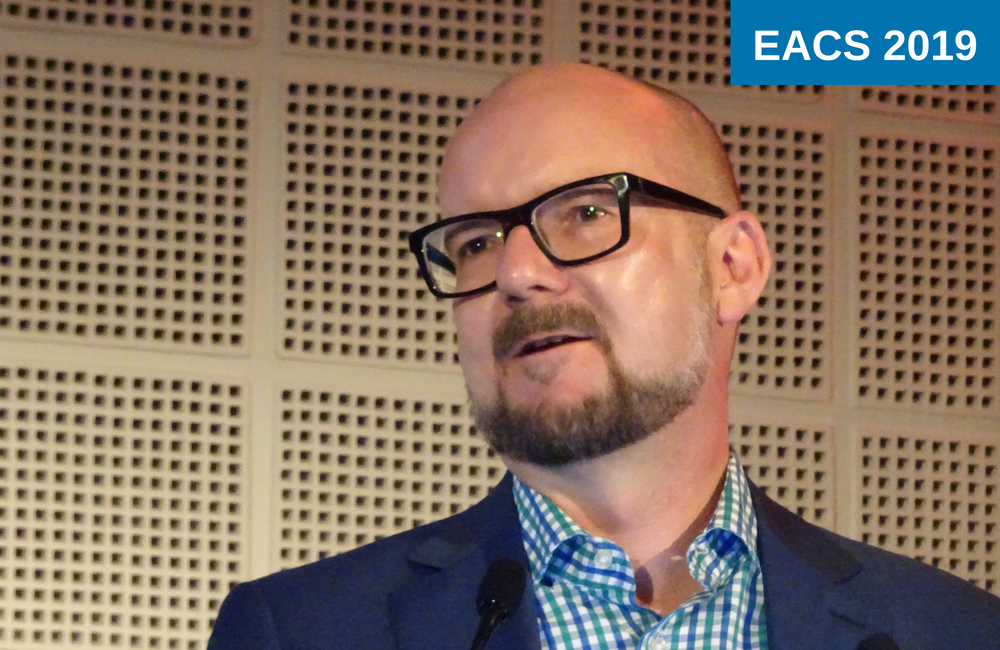
An Australian study of gay men recruited in community settings in Sydney, Australia has found a very high prevalence of HSIL (high-grade squamous intraepithelial lesions – precancerous changes in the cells of the anal lining that may indicate a risk of developing cancer).
Yet in three years of follow-up, only one man out of 617 progressed to anal cancer, the 17th European AIDS Conference (EACS 2019) in Basel, Switzerland heard.
The researchers also found that the development of anal lesions was no higher in smokers and not much higher in men with HIV, both groups thought to be at higher risk.
The researchers also found that the clearance of HSIL – the rate at which abnormal cells revert back to normal type or to a lower grade of abnormality – was actually higher than the rate of acquisition. This meant that HSIL was more common in younger men than older; if the clearance rate was slower that the acquisition rate, HSIL would become more common with age. However, if older men did have HSIL, it took longer to clear.
Dr David Templeton of SPANC (Study for the Prevention of Anal Cancer) study said that its purpose was to see if routine screening of gay men for anal lesions would be worth doing to prevent anal cancer.
About anal cancer, HPV and HSIL
Anal cancer, like cervical cancer in women, is almost always caused by the human papillomavirus, HPV, which also causes genital warts.
David Templeton told the conference that anal cancer is rare in the general population, with about one case per 100,000 people per year. Previous surveys indicate it is between five to 20 times more common in HIV-negative gay men, ten times more common in HIV-positive people who are not gay men, and 50 to 100 times more common in HIV-positive gay men (roughly one in a thousand men a year).
HPV is extremely contagious and spread through almost any contact with the mucous membranes lining the anus, cervix or mouth, but the immune system usually clears single infections within a year or two. Only certain subtypes of the more than 100 HPV varieties cause cancer, of which HPV16 is the most common, and one of the four varieties that the Gardasil HPV vaccine now given to adolescents in many countries prevents. The reason for the higher rates in gay men and in HIV-positive people is that HPV infection is already more frequent in people who have anal sex, and infections are also cleared more slowly by people with impaired immunity (transplant patients, who have artificially depressed immunity, also have higher rates).
Anal cancer is now among the most common cancers in people living with HIV. It has become more common over time in Australia, with 70 cases per 100,000 a year in HIV-positive men between 2009 and 2012 compared to 20 per 100,000 between 1996 and 2000 – probably caused by more people living long enough to develop it.
The SPANC study
SPANC recruited 617 gay and bisexual men aged 35 or over between September 2009 to May 2018. They had anal swabs and examinations taken at the start of the study, six months later, and one, two and three years after recruitment.
There are several ways of grading anal and cervical cancer, to do with the appearance of cells and the area of tissue they cover. They are classed as low-grade or high-grade squamous intraepithelial lesions (LSIL or HSIL) in terms of cellular appearance and AIN (anal intraepithelial neoplasia) grades 1, 2, or 3 in terms of the thickness of tissue affected. HSIL+AIN3 is the highest-risk combination of grades in terms of cancer risk.
In SPANC, this highest grade was very common. At baseline, a third of HIV-negative men and nearly half (47%) of HIV-positive men had HSIL; 25% 0f negative men and 38% of positive men had HSIL+AIN3.
That is baseline prevalence. But because SPANC is a longitudinal study, it could also do what few anal cancer studies have done before and accurately report incidence – the proportion of men who developed HSIL anew ever year.
The overall annual incidence of the development of HSIL (from no SIL or from LSIL) was 11% – HSIL was diagnosed 124 times in 1097 person-years in the study. Most of those were new progressions (88 in 845 person-years) but there were 36 progressions back to HSIL in 154 person-years in men who had previously cleared it, an incidence of re-progression of 23% a year in this group.
New or renewed progression to HSIL was related to one factor – age. Incidence in men aged 35-44 was 16% and in men 45 or over 10% (the average age in the study was 50 and the minimum 35).
"The development of anal lesions was no higher in smokers and not much higher in men with HIV, both groups thought to be at higher risk."
More surprisingly, it was not related to one factor that has been reported as a risk factor in other studies – smoking. Eleven per cent of HIV-negative and 20% of HIV-positive men were current smokers, but they did not develop HSIL any faster than non-smokers.
HIV status was only marginally related to HSIL incidence. Incidence of HSIL was 14% a year in HIV-positive men and 10% in HIV-negative men, and this difference just failed to reach statistical significance (p = 0.054).
Clearance of HPV infection, and especially HPV16 infection, made HSIL diagnosis less likely. Incidence in men who had tested positive for HPV16 infection at the last two visits was 27% a year. Compared with that, men who tested positive only at the last visit were 26% less likely to be diagnosed with HSIL, those who’d only tested positive the visit before last were 65% less likely, and those negative for HPV16 in the last two visits 72% less likely.
Incidence in men who tested positive for other HPV strains but not HPV16 at both of the last two visits was 13%. But even men with negative tests for HPV in the last two visits had a 2.3% chance of developing HSIL, showing that the changes to skin cells caused by HPV infections may continue to happen even after viral infection has disappeared.
One important and encouraging finding was that clearance of HSIL – its regression either to normal cells or to LSIL – was more common than its appearance. Twenty-two per cent of men cleared their HSIL per year compared with 11% who developed it, and in men who had only had it diagnosed in the last year, 44% cleared it. Men aged 45 or older were one-third less likely to clear HSIL than younger men.
There was, perhaps surprisingly, no relationship between clearance rate and HIV status. HIV-positive men were at least as likely to clear their HSIL as negative men. And there was no relationship with smoking either.
However, while clearance of HPV16 infection meant that HSIL clearance was 74% more likely, only 14% of men with persistent HPV16 infection (defined as two subsequent positive HPV16 tests) cleared HSIL per year. This shows why persistent HPV16 infection is such a red flag for anal cancer.
There was, however, only once new (incident) case of anal cancer in the whole study, in an HIV-negative man, representing one case in 444 person-years, or one in 241 HIV-negative men. There were two other cases diagnosed but it is thought that these men already had anal cancer when they entered the study, so they cannot be counted as incident infections. It is very difficult to calculate a population incidence from one case but this does seem to be out of line with the very high incidence rates quoted for gay men and especially HIV-positive gay men in previous studies. Linkage to larger cohort studies may provide more robust figures.
David Templeton said that active monitoring of HSIL should probably be conducted more often in younger men as they were more likely to develop cellular abnormalities, and there might be a role for the new HPV vaccine against nine HIV subtypes. But actual treatment in the sense of removing lesions as well as vaccines to prevent infections with more subtypes should be reserved for older men with persistent HPV infection that is failing to clear, he said.
Templeton D J et al. The natural history of anal high grade squamous intraepithelial lesions in HIV-positive and HIV-negative gay and bisexual men. 17th European AIDS Conference, Basel, abstract PS6/1, 2019.
Update: Following the conference presentation, this study was published in a peer-reviewed journal:
Poynton M et al. The natural history of anal high-grade squamous intraepithelial lesions in gay and bisexual men. Clinical Infectious Diseases, ciaa166, April 2020.

